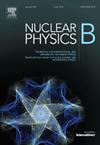BMS symmetries of gravitational scattering
IF 2.5
3区 物理与天体物理
Q2 PHYSICS, PARTICLES & FIELDS
引用次数: 0
Abstract
After motivating the relevance of the Bondi-Metzner-Sachs (BMS) group over the last decades, we review how concepts such as Penrose diagrams and the covariant phase space formalism can be used to understand the asymptotic structure of asymptotically flat spacetimes (AFS). We then explicitly construct the asymptotic symmetry group of AFS in dimensions, the BMS group. Next, we apply this knowledge to the usual far-field scattering problem in general relativity, which leads to the unravelling of the intrinsic features of gravity in the infrared. In particular, we work out the connections between asymptotic symmetries, soft theorems in quantum field theories and gravitational memory effects. We restrict to the study of this infrared triangle through the lens of supertranslations here, but the analogous features that can be found in the case of superrotations or for other gauge theories are also motivated at the end of our discussion. We conclude with an overview of the implications of the infrared triangle of gravity for the formulation of an approach to quantum gravity through holography, as well as a brief discussion of its potential in tackling the black hole information paradox.
This review article arose from an essay submitted for the partial fulfilment of the requirements for the degree of Master of Advanced Study in Applied Mathematics (Part III of the Mathematical Tripos) at the University of Cambridge, set by Dr. Prahar Mitra and submitted by the author in May 2023. It is aimed at advanced undergraduate students or early postgraduate students willing to learn about the role of asymptotic symmetries in the context of flat space holography, with only basic knowledge of quantum field theory and general relativity assumed.
Note
Another comprehensive review on this topic by Laura Donnay [1] appeared between the submission of this essay and its publication. The present review provides complementary background material and includes explicit derivations, which may be useful to young researchers.
引力散射的BMS对称性
在回顾了近几十年来Bondi-Metzner-Sachs (BMS)群的相关性之后,我们回顾了如何使用彭罗斯图和协变相空间形式化等概念来理解渐近平坦时空(AFS)的渐近结构。然后明确构造了3+1维AFS的渐近对称群,即BMS群。接下来,我们将这些知识应用于广义相对论中常见的远场散射问题,这导致了红外引力固有特征的解开。特别地,我们研究了渐近对称性、量子场论中的软定理和引力记忆效应之间的联系。在这里,我们仅限于通过超平移透镜来研究这个红外三角形,但是在超旋转的情况下或其他规范理论中可以找到的类似特征也在我们讨论的最后得到了激发。最后,我们概述了红外引力三角形对通过全息法研究量子引力的影响,并简要讨论了它在解决黑洞信息悖论方面的潜力。这篇综述文章源于一篇由Prahar Mitra博士于2023年5月提交的论文,该论文是为了部分满足剑桥大学应用数学高级研究硕士学位(数学博士学位第三部分)的要求而提交的。本课程面向有意愿了解渐近对称性在平面空间全息中的作用的高年级本科生或研究生,只需要具备量子场论和广义相对论的基础知识。在这篇文章提交和发表之间,Laura Donnay b[1]对这个主题进行了另一次全面的回顾。本综述提供了补充的背景材料,包括明确的推导,这可能对年轻的研究人员有用。
本文章由计算机程序翻译,如有差异,请以英文原文为准。
求助全文
约1分钟内获得全文
求助全文
来源期刊

Nuclear Physics B
物理-物理:粒子与场物理
CiteScore
5.50
自引率
7.10%
发文量
302
审稿时长
1 months
期刊介绍:
Nuclear Physics B focuses on the domain of high energy physics, quantum field theory, statistical systems, and mathematical physics, and includes four main sections: high energy physics - phenomenology, high energy physics - theory, high energy physics - experiment, and quantum field theory, statistical systems, and mathematical physics. The emphasis is on original research papers (Frontiers Articles or Full Length Articles), but Review Articles are also welcome.
 求助内容:
求助内容: 应助结果提醒方式:
应助结果提醒方式:


